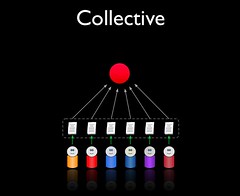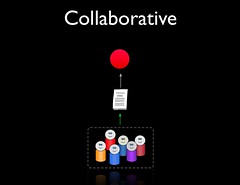One of the things that has been a little bothersome in the last year or two and has been the lack of understanding between the difference between two terms, collaborative and collective. The two terms are rather similar in definition (in some dictionaries they are nearly identical), but the differences between the two terms have a huge difference when it comes to value in social software. This difference and value is often overlooked or missed by those crafting these tools and services, which I hope gets corrected as both have great value and compliment each other.
The last year these confusion between the two terms became really frustrating as tools and services were being touted as being collaborative that were only based on collective social interaction. When the Wikipedia entry for folksonomy moved to make the statement that folksonomy is synonymous with collaborative tagging, it deeply bothered me as the term folksonomy was coined to separate tagging done in a collective manner (each individual’s contribution is held separate and collected or aggregated to build a fuller understanding, as the tagging is done by and from the individual reading the media for their own retrieval and is also share out with others). Collaborative tagging does take place and there is a need for it in certain situations, but it is not folksonomy. The following mini tutorial should help move the understanding of collective and collaborative forward. I have received much encouragement from academics and social computing researcher and social craftspeople that really need to have the differentiation of these terms brought into clearer light to help move forward the creation of better tools and services.
Social Tools and Services
To start this tutorial the understanding of the object that is central to social interaction need to be understood. Often in digital social environments there is a social object that is at the core of the discussion (see Jyri Engestrom’s post on Karin Cetina Knorr’s “object mediated sociality”, which he brings to the web an understanding of social objects). These social objects form the frame of focus for discussion and social interaction, be it a photo in Flickr or a post in a person’s blog that is being discussed in the comments or tagged, annotated, or blogged about in another post, much of the social web is built upon social objects or the creation of sociality around objects. These social objects are the focus of this discussion as it is the focus of the discussion and annotation that is being brought into focus here.
Collective

I am starting with the collective understanding. The collective as seen in the first graphic has three layers: 1) the object being discussed; 2) the discussion or annotation of or about the object; 3) the people annotating or discussing the object. The object is the focus of collective, the individual’s voices and annotations are held separate as each individual is working as an individual. The individuals annotations and contributions can be aggregated or collected (a helpful connection is the collective is based on collecting) and surfaced as an aggregate. This aggregate is what allows folksonomy, as it surfaced in del.icio.us providing understanding how many people use a single tag term on an object. But, this same approach in folksonomy helps discern slight or vast differences between understanding around an object. We can see what an object may be commonly by many in a folksonomy, but we can also see differences in perspective and context.
The deep and rich value in tagging from a folksonomy perspective is created in the collective structure of tagging with the individual voices held separate around the understanding of the individual. The ability for anybody and everybody to tag and annotate and object and have their perspective captured is a very strong value for each individual who has hopes of refinding the object in their own perspective and context, as well as having others whom have similar understanding find the same object. Lacking the understanding of collective approach is lacking the understanding of folksonomy and leave incredible value out of a service as the depth and breadth of understanding supports the human collective mind as it exists.
Collaborative
 The collaborative understanding has value as it allows for capturing consensus and usually aims at completeness. The collaborative approach has individuals contributing understanding of their perspective of an object, but it done so with everybody working together to build one understanding (often a comprehensive understanding), but often with the aim of the work building the understanding out of one voice capturing many perspectives. The depth and of understanding is flattened – if the object is a picture of a sunset, once it is annotated as being a sunset there is no value in many others making the same statement. Quite often a wiki page on a subject is used as an example of a collaborative effort.
The collaborative understanding has value as it allows for capturing consensus and usually aims at completeness. The collaborative approach has individuals contributing understanding of their perspective of an object, but it done so with everybody working together to build one understanding (often a comprehensive understanding), but often with the aim of the work building the understanding out of one voice capturing many perspectives. The depth and of understanding is flattened – if the object is a picture of a sunset, once it is annotated as being a sunset there is no value in many others making the same statement. Quite often a wiki page on a subject is used as an example of a collaborative effort.
Social bookmarking can be collaborative when a group is working to capture all objects on a subject matter and annotate them, but this is rare occurrence. There is a need for this when organizations are doing competitive analysis of other organizations work on a subject matter and the aim is to be as exhaustive as possible. Often the competitive exercises are done in selective social spaces that are closed to all but members of the group doing the work.
In the past I have describe Flickr as a narrow folksonomy, which is a rough synonym for collaborative tagging. There is value missing in Flickr tagging (I am always hopeful they will add the collective individual tagging into Flickr as I see great value to the service and the individuals who are tagging other people’s photos by being able to tag a photo of a sunset as a sunset, which would all the person tagging to have a nice collection of things they call sunset as well as reinforce it is about a sunset). Flickr does allow for this type of tagging to a degree, but only provides access to the tags by API (Flickr has had many other things on their plate that the community has placed higher priority on). But, the collaborative tagging approach is often copied from Flickr by services that do not have the massive user contribution, which provides Flickr to do insanely brilliant algorithmic understanding of what is in their service (like interestingness and clustering).
The understanding of collaboration has trickled out of business and academic understanding of most anything social in an organization being categorized as being collaborative. The aim in the 1990s was for business and organizations to use digital collaboration tools to let people to work together across distance and to capture understanding. At this point most of what was being done was collaborative, with the focus on building one document or deliverable (marketing report and sale projections, etc.). Many of the tools that business used and the academic community in information science studied were tools that were trying to foster collaboration or a collaborative knowledge with in the organization.
Tools Improved and Collaborative and Collective Tools Evolved
Today we have grown well beyond the relatively poor tool foisted upon unsuspecting employees as knowledge management tools with the wonderful goal of capturing and sharing knowledge (often through complex tools that created excuses for adding new required form fields) [I have lived through the implementation and non-use of many of these painful KM tools, which did market what is now capable and far less painful in the tools of today]. Today people wanting to hold on to information or a media object can easily bookmark the object in their social bookmarking tool from their own perspective to greatly ease refinding the object later, as well as share that object with others who are near in thought or have similar interests. This collective approach is still being incorrectly called collective through habit of calling anything social collaborative even though the tools that are now delivering on the promise of the last 15 years (which the tools of the past damaged the hope that proper tools could work).
Those building tools and implementing tools (I am looking squarely at you large consulting firms who use the old models to mis-understand, provide poor strategy, and improperly implement tools that should work well) must expand their vocabulary and understanding by one term and add collective to their lovely term (when used properly) collaborative.

Leave a Reply